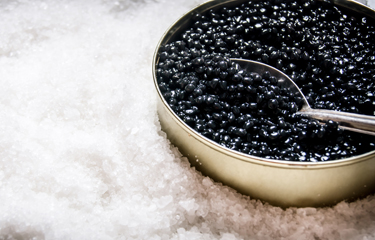A proposal by U.S. Fish and Wildlife Service to list multiple species of sturgeon on the Endangered Species Act (ESA) is being decried by the caviar industry and NGOs alike.
The proposal, posted by the Fish and Wildlife Service on 25 May, would classify four species of sturgeon as endangered: Russian sturgeon (Acipenser gueldenstaedtii), ship sturgeon (A. nudiventris), Persian sturgeon (A. persicus), and stellate sturgeon (A. stellatus). If finalized, the rule would make importing, exporting, taking, possessing, or other actions related to the four species illegal and would prohibit “delivery, receipt, carriage, transport, or shipment in interstate or foreign commerce.”
The problem, according to several members of the aquaculture industry, is that the ruling attributes the restrictions to the species “wherever found,” which would effectively ban all commerce of caviar regardless of source – even if it has been farmed sustainably. The exemptions required to continue trading in the species wouldn’t be feasible, they claim.
The proposed changes stem from a scientific review of the habitats of the species, which determined that wild stocks of all four are heavily threatened by a combination of overfishing, dammed rivers, and illegal poaching.
While the wild stocks do face severe challenges, Fort Lauderdale, Florida, U.S.A.-based Caviar & Caviar President Michael Jalileyan told SeafoodSource that multiple species of sturgeon, and the caviar that comes from it, have been farmed for decades sustainably with little to no impact on wild stocks.
“Caviar has been sustainable and farmed now for 15-plus years, so 100 percent of what we import as sturgeon roe is farmed,” he said. “The ESA law is from 1973, and it doesn’t take into consideration that things will be farmed in aquaculture.”
According to Jalileyan, farmed caviar supply chains are easily traceable, and the industry itself is a major contributor to efforts to protect endangered sturgeon.
“The caviar industry is a leader in terms of conservation and transformation of modernizing aquaculture and food supply. We've taken a set of sturgeon species on the brink of extinction and populated them over 200 percent from their existing wild stocks in the past decade globally,” he said. “Leading farmers, producers, and processors should be applauded and further encouraged by conservationists and governments for such a great achievement in terms of recovery of the species and the [recirculating aquaculture system] techniques undertaken.”
The National Aquaculture Association, in a public comment on the proposal, said several other commercial seafood species face bifurcated markets where species are endangered in the wild but traded legally when raised via aquaculture. Atlantic salmon, it lists as an example, is endangered in the Gulf of Maine but not elsewhere in its natural range, including in Greenland, and several countries in Europe. Global farmed Atlantic salmon production was estimated to be 2.7 million metric tons in 2020, with 17,690 metric tons of the species produced in Maine where it is listed as endangered – showing a blanket trading ban is unncessary and damaging to industry, the NAA said.
“We request the U.S. Fish and Wildlife Service list Russian and stellate sturgeons only within their natural range within the Code of Federal Regulations as authorized by Congress,” NAA President Sebastian Belle wrote.
Another key factor, Belle said, is that it a method for quickly differentiating caviar sourced from wild surgeon and caviar from aquaculture has been known for over a decade. A scientific study performed in 1995 showed that commercial sturgeon diets yield farmed fish with a “higher concentration of linoleic acid” in both the caviar and flesh than wild counterparts. A quick chromatographic analysis of fatty acids can showcase the “stark contrast” between wild and aquaculture sourced products, Belle said.
“In addition to simple and inexpensive lipid analysis, [there is research showing] several molecular methods available for species identification, among them polymerase chain reaction (PCR)–restriction fragment length polymorphism, PCR sequencing, PCR-specific primers, real-time PCR, and microarray technology,” Belle said.
The World Sturgeon Conservation Society (WSCS) has also petitioned U.S. Fish and Wildlife Service to reconsider its proposed regulation.
“The WSCS recognizes that this proposal was initiated out of concern and good intention, but we are convinced that it will prove counterproductive in the worst case to work towards sustainable management of wild resources and to protect the sturgeon species in question,” the WSCS wrote.
The society said all of the species being considered for listing as endangered are already subject to the Convention on International Trade in Endangered Species (CITES), and that sturgeon fisheries in almost all countries in the species’ range are currently shut down. Because of this, aquaculture is currently the only legal source of sturgeon meat and products, and the commercial utilization of sturgeon via aquaculture is “subject to detailed control of the respective states and of international conventions.”
The WSCS said the U.S. could be more-effective in protecting sturgeon species by adopting CITES regulations and labeling on caviar products. It said illegally-caught sturgeon is typically sold locally, so a U.S. ban on sturgeon imports would have no practical impact in curbing poaching.
“When limiting market access for farmed caviar, the demand might search for alternative supply, thereby fueling illegal harvest and smuggling,” the WSCS said.
For companies like Caviar & Caviar, the move would be catastrophic, Jalileyan said he hopes the U.S. Fish and Wildlife Service chooses to rethink its initial proposal.
“Understanding the full integration of sustainability, ethical trade, and captive breeding systems that maintain almost a net-zero effect on their respective settings, this should be considered as a model for the future of many fish farmers worldwide,” he said. “We do consider the USFWS to be logical and reasonable actors and hope they will, after full review, understand the present day facts and proceed in the best interest of our industry and the continued welfare and propagation of sturgeon species.”
Photo courtesy of ArtemSh/Shutterstock







